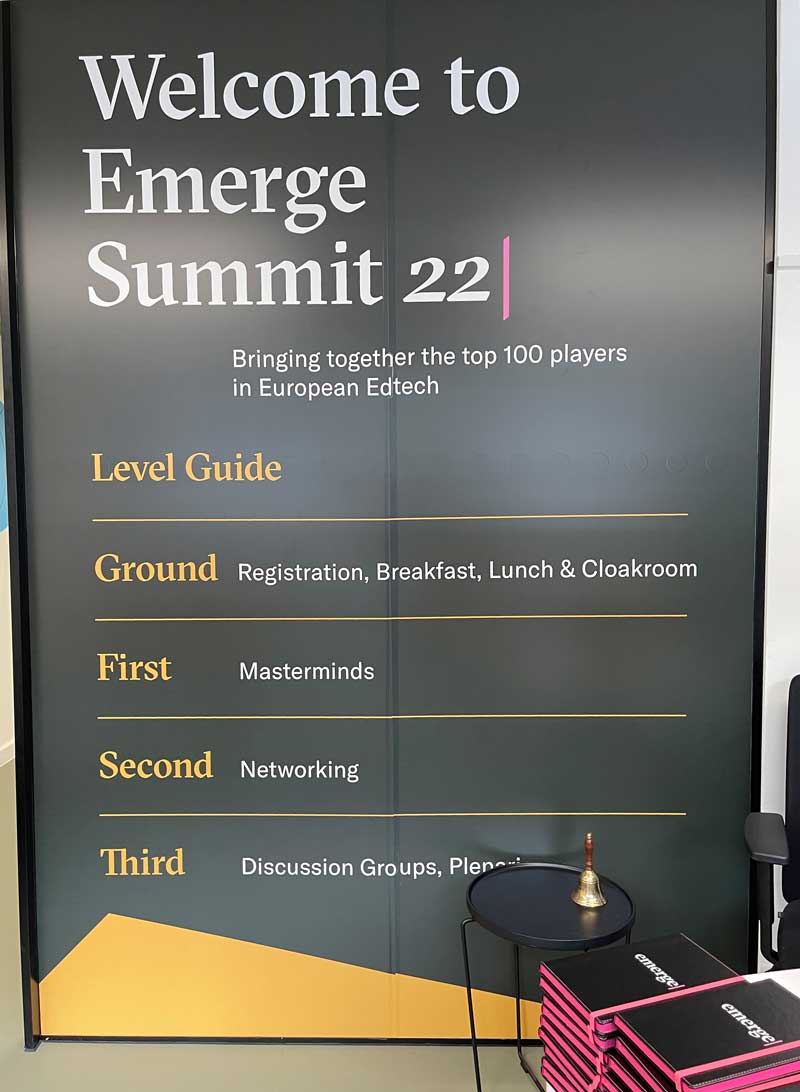An introduction to Jan Lynn-Matern, founder and partner of Emerge Education at the ASU/GSV Summit in April led to an invitation to attend the Emerge Summit 22 in London last week.
The Summit was held at the London Interdisciplinary School (LIS) in Whitechapel, London. LIS is one of Emerge Education’s investments. It’s worth a visit to their website to find out more about this school where the education takes the learner through a multi-disciplinary approach of learning concepts and methods to solve problems, including ones that each student proposes.
The conference kicked off with a plenary session for the group assembled where Emerge’s partners shared their story. The Emerge team has made 71 investments to date, primarily seed funding. The partners at Emerge publish their investment theses on their website with a goal of attracting new investors to their fund(s) as well as helping founders decide what to build.
To differentiate themselves from other Venture Capital firms, the partners at Emerge have built a community designed to aid founders of their portfolio companies to learn from the best, build a peer group, get top advisors, and to get customer feedback. As a result, 100 percent of companies receiving pre-seed funding from Emerge convert to seed funding and 75 percent of companies receiving seed funding convert to Series A funding. With conversion rates this high, it’s only natural that Emerge’s investment returns are in the top quartile, 50 percent of its founders are women, and 56 percent of its founders are people of color.
Emerge’s partners remarked that Europeans are building global category leaders thanks to their “day one” global mindset (it was noted that the U.S. is such a large ed tech market on its own that many U.S. companies are satisfied to build products solely for the U.S. market). They also noted that publicly traded tech stocks have declined recently and that for the next 18 months, funding will be tougher for startups.
The Emerge team believes that there are four macro trends that are transforming education. These trends are:
- Automation ($8.5 trillion skills gap by 2030, driven by automation)
- Consumer Demographics (50% shortage of global university places by 2035)
- Digitization (2020 market the start of a global transition to online)
- Globalization (24% of the global workforce will be fully remote)
The team also remarked that assuming the developed world is about to enter a recession, college attendance has increased in every recession since the 1960’s.
Emerge invests in the future of learning. Learning leads to jobs, and jobs require talented individuals. Some Emerge portfolio companies improve access and outcomes for university students, some provide cost-effective and flexible pathways into employment, some enable employers to access, develop, and retain talent, and some provide new consumer education platforms. Examples were presented of specific portfolio companies that focus each of these areas to fuel their growth.

The Emerge team spoke about their EdTech Founders Club. This invitation only network includes more than 70 founders who have raised more than $10M in funding. Another group, the Venture Partners group includes 40+ exited founders and senior EdTech executives who provide advising to Emerge and to Emerge portfolio CEO’s. Lastly, Emerge has created a Learning Partners group consisting of 150+ learning and people leaders at universities and companies. The purpose of this group is to provide early customer feedback for portfolio companies.
The Summit had five panel discussions. The topics for these included:
- Future of Higher Education
- Future of Workforce Development
- Future Pathways into Employment
- New models in EY & K12 education
- Growth Investor panel
Participants on these panels included Emerge partners, Emerge investors, and Emerge portfolio company CEO’s. Meanwhile, the Emerge team cleverly paired up summit participants in curated networking sessions that allowed them to spend 30 minutes with someone that might be helpful to the CEO’s.
I participated on the Growth Investor panel as well as in the curated networking sessions. During the opening plenary session, the Emerge partners stated that the goals for the summit were threefold: provide peer-to-peer support, establish new relationships, and provide market insights. I’m certain they accomplished all three. If you didn’t meet someone you wanted to meet during the day, there were more opportunities over breakfast, lunch, and dinner.
The ASU/GSV conference has established itself over the past dozen years as “the” EdTech conference in the U.S. This past year, approximately 6,000 participants traveled to San Diego for the opportunity to hear market insights, listen to presentations from various companies, and network with new and old friends. This year’s Emerge Summit reminded me of the first year that the ASU/GSV conference was established with less than 200 people meeting at ASU’s Skysong facility in Phoenix. “It’s a lot easier to confer if you don’t exceed 100 people,” was an explanation for the size of the attendance that I received many years ago while attending a small conference at Oxford University. There are benefits to attending both types of conferences, but as for meeting new acquaintances, I met more people for the first time at the Emerge Summit than I met for the first time at this year’s ASU/GSV. Kudos to Emerge Education for hosting a fantastic inaugural summit! P.S., I’d love to attend next year’s conference.











